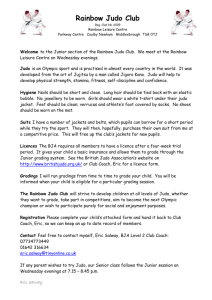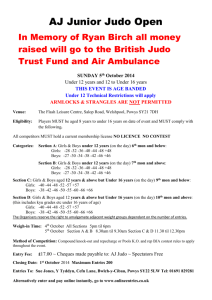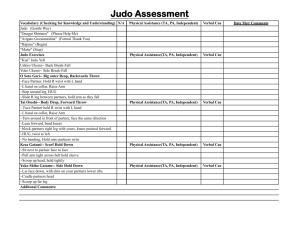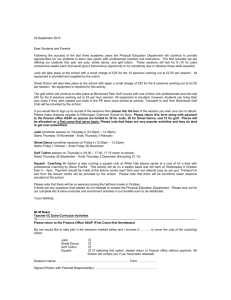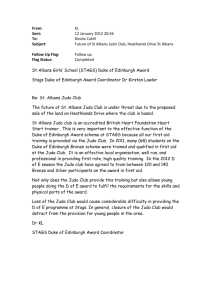NAGE KOMI 1
advertisement
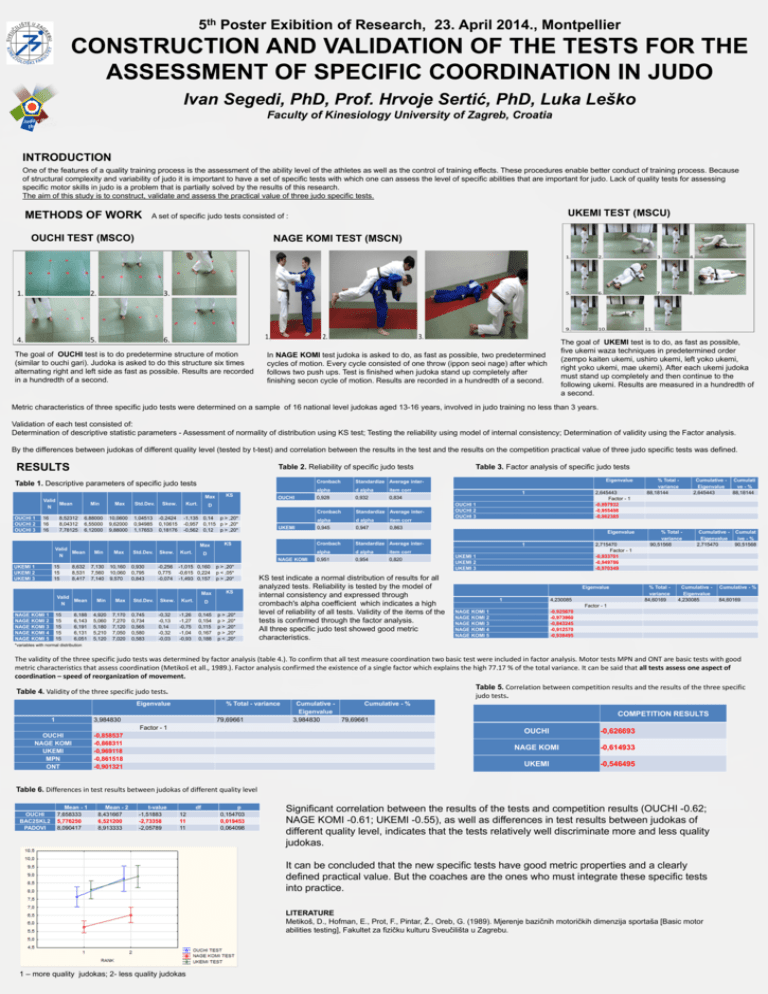
5th Poster Exibition of Research, 23. April 2014., Montpellier CONSTRUCTION AND VALIDATION OF THE TESTS FOR THE ASSESSMENT OF SPECIFIC COORDINATION IN JUDO Ivan Segedi, PhD, Prof. Hrvoje Sertić, PhD, Luka Leško Faculty of Kinesiology University of Zagreb, Croatia INTRODUCTION One of the features of a quality training process is the assessment of the ability level of the athletes as well as the control of training effects. These procedures enable better conduct of training process. Because of structural complexity and variability of judo it is important to have a set of specific tests with which one can assess the level of specific abilities that are important for judo. Lack of quality tests for assessing specific motor skills in judo is a problem that is partially solved by the results of this research. The aim of this study is to construct, validate and assess the practical value of three judo specific tests. METHODS OF WORK OUCHI TEST (MSCO) 1. NAGE KOMI TEST (MSCN) 2. 4. UKEMI TEST (MSCU) A set of specific judo tests consisted of : 3. 5. 1. 6. The goal of OUCHI test is to do predetermine structure of motion (similar to ouchi gari). Judoka is asked to do this structure six times alternating right and left side as fast as possible. Results are recorded in a hundredth of a second. 2. 3. 1. 2. 3. 4. 5. 6. 7. 8. 9. 10. 11. The goal of UKEMI test is to do, as fast as possible, five ukemi waza techniques in predetermined order (zempo kaiten ukemi, ushiro ukemi, left yoko ukemi, right yoko ukemi, mae ukemi). After each ukemi judoka must stand up completely and then continue to the following ukemi. Results are measured in a hundredth of a second. In NAGE KOMI test judoka is asked to do, as fast as possible, two predetermined cycles of motion. Every cycle consisted of one throw (ippon seoi nage) after which follows two push ups. Test is finished when judoka stand up completely after finishing secon cycle of motion. Results are recorded in a hundredth of a second. Metric characteristics of three specific judo tests were determined on a sample of 16 national level judokas aged 13-16 years, involved in judo training no less than 3 years. Validation of each test consisted of: Determination of descriptive statistic parameters - Assessment of normality of distribution using KS test; Testing the reliability using model of internal consistency; Determination of validity using the Factor analysis. By the differences between judokas of different quality level (tested by t-test) and correlation between the results in the test and the results on the competition practical value of three judo specific tests was defined. RESULTS Table 2. Reliability of specific judo tests Table 1. Descriptive parameters of specific judo tests Max Valid Mean N OUCHI 1 OUCHI 2 OUCHI 3 16 16 16 Min 8,52312 8,04312 7,78125 6,88000 6,55000 6,12000 Valid Mean N UKEMI 1 UKEMI 2 UKEMI 3 15 15 15 8,632 8,531 8,417 Valid Mean N NAGE NAGE NAGE NAGE NAGE KOMI 1 KOMI 2 KOMI 3 KOMI 4 KOMI 5 15 15 15 15 15 6,188 6,143 6,191 6,131 6,051 Max 10,0600 9,62000 9,88000 Std.Dev. 1,04513 0,94985 1,17653 Skew. -0,2424 0,10615 0,18176 Kurt. Max Std.Dev. Skew. OUCHI -1,135 0,14 p > ,20* -0,957 0,115 p > ,20* -0,562 0,12 p > ,20* Kurt. UKEMI KS D NAGE KOMI 7,130 7,560 7,140 10,160 10,060 9,570 0,930 0,795 0,843 -0,256 0,775 -0,074 -1,015 0,160 -0,615 0,224 -1,493 0,157 Max Min 4,920 5,060 5,180 5,210 5,120 Max 7,170 7,270 7,120 7,050 7,020 Std.Dev. 0,745 0,734 0,565 0,580 0,583 Skew. -0,32 -0,13 0,14 -0,32 -0,03 Kurt. -1,26 -1,27 -0,75 -1,04 -0,93 Standardize Average inter- alpha d alpha item corr 0,928 0,932 0,834 D Max Min KS Cronbach p > ,20* p < ,05* p > ,20* KS D 0,145 0,154 0,115 0,167 0,188 p > ,20* p > ,20* p > ,20* p > ,20* p < ,20* Cronbach Standardize Average inter- alpha d alpha item corr 0,945 0,947 0,863 Cronbach Standardize Average inter- alpha d alpha item corr 0,951 0,954 0,820 KS test indicate a normal distribution of results for all analyzed tests. Reliability is tested by the model of internal consistency and expressed through crombach's alpha coefficient which indicates a high level of reliability of all tests. Validity of the items of the tests is confirmed through the factor analysis. All three specific judo test showed good metric characteristics. Table 3. Factor analysis of specific judo tests Eigenvalue 1 2,645443 Factor - 1 -0,897932 -0,955498 -0,962385 OUCHI 1 OUCHI 2 OUCHI 3 Eigenvalue 1 2,715470 Factor - 1 -0,933701 -0,949786 -0,970349 UKEMI 1 UKEMI 2 UKEMI 3 Eigenvalue 1 % Total variance 88,18144 % Total variance 90,51568 % Total variance 84,60169 4,230085 Cumulative Eigenvalue 2,645443 Cumulative Eigenvalue 2,715470 Cumulative Eigenvalue 4,230085 Cumulati ve - % 88,18144 Cumulat ive - % 90,51568 Cumulative - % 84,60169 Factor - 1 NAGE NAGE NAGE NAGE NAGE KOMI 1 KOMI 2 KOMI 3 KOMI 4 KOMI 5 -0,925670 -0,973960 -0,843245 -0,912570 -0,938495 *variables with normal distribution The validity of the three specific judo tests was determined by factor analysis (table 4.). To confirm that all test measure coordination two basic test were included in factor analysis. Motor tests MPN and ONT are basic tests with good metric characteristics that assess coordination (Metikoš et all., 1989.). Factor analysis confirmed the existence of a single factor which explains the high 77.17 % of the total variance. It can be said that all tests assess one aspect of coordination – speed of reorganization of movement. Table 5. Correlation between competition results and the results of the three specific judo tests. Table 4. Validity of the three specific judo tests. Eigenvalue 1 % Total - variance 3,984830 79,69661 Factor - 1 OUCHI NAGE KOMI UKEMI MPN ONT -0,858537 -0,868311 -0,969118 -0,861518 -0,901321 Cumulative Eigenvalue 3,984830 Cumulative - % COMPETITION RESULTS 79,69661 OUCHI -0,626693 NAGE KOMI -0,614933 UKEMI -0,546495 Table 6. Differences in test results between judokas of different quality level OUCHI BAC2SKL2 PADOVI Mean - 1 7,658333 5,776250 8,090417 Mean - 2 8,431667 6,521200 8,913333 t-value -1,51883 -2,73358 -2,05789 df 12 11 11 p 0,154703 0,019453 0,064098 Significant correlation between the results of the tests and competition results (OUCHI -0.62; NAGE KOMI -0.61; UKEMI -0.55), as well as differences in test results between judokas of different quality level, indicates that the tests relatively well discriminate more and less quality judokas. It can be concluded that the new specific tests have good metric properties and a clearly defined practical value. But the coaches are the ones who must integrate these specific tests into practice. LITERATURE Metikoš, D., Hofman, E., Prot, F., Pintar, Ž., Oreb, G. (1989). Mjerenje bazičnih motoričkih dimenzija sportaša [Basic motor abilities testing], Fakultet za fizičku kulturu Sveučilišta u Zagrebu. 1 – more quality judokas; 2- less quality judokas

